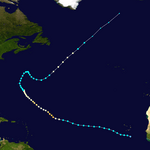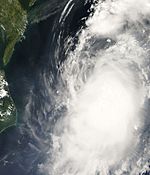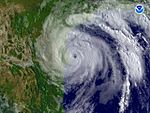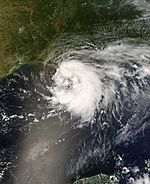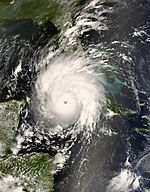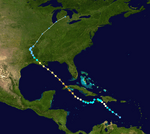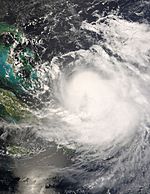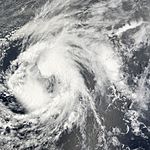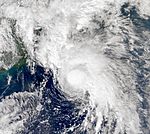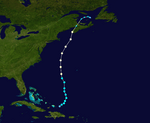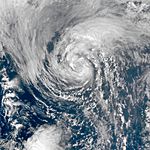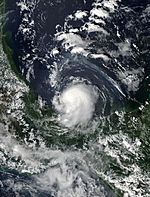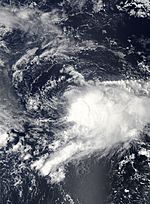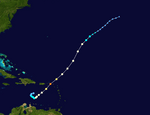2008 Atlantic hurricane season facts for kids
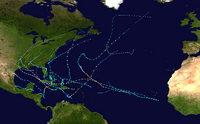 |
|
| First storm started: | May 30, 2008 |
| Last storm ended: | November 10, 2008 |
| Strongest storm: | Hurricane Ike - 935 mbar, 145 mph (230 km/h) winds |
| Total storms: | 16 |
| Hurricanes: | 8 |
| Major hurricanes (Cat. 3+) | 5 |
| Cost of damage: | $42 billion (2009 USD) |
| People killed: | 885 direct, 192 indirect |
| Atlantic hurricane seasons: | 2006 2007 2008 2009, 2010 |
The 2008 Atlantic hurricane season was a time when many tropical cyclones formed in the Atlantic Ocean. A tropical cyclone is a rotating storm system with a low-pressure center. The season officially started on June 1 and ended on November 30, 2008. However, Tropical Storm Arthur formed a bit early on May 30. During this season, there were 16 named tropical storms, 8 hurricanes, and 5 major hurricanes.
Contents
- Storms of the 2008 Hurricane Season
- Tropical Storm Arthur: The Early Start
- Hurricane Bertha: A Long-Lived Storm
- Tropical Storm Cristobal: Skirting the Coast
- Hurricane Dolly: Texas Landfall
- Tropical Storm Edouard: Gulf Coast Storm
- Tropical Storm Fay: Four Landfalls in Florida
- Hurricane Gustav: A Powerful Threat
- Hurricane Hanna: Deadly Rains
- Hurricane Ike: A Giant Storm
- Tropical Storm Josephine: Fading in the Ocean
- Hurricane Kyle: Canada's Turn
- Tropical Storm Laura: A Subtropical Start
- Tropical Storm Marco: The Smallest Storm
- Tropical Storm Nana: A Rare Name
- Hurricane Omar: Unexpected Strength
- Tropical Depression Sixteen: Inland Dissipation
- Hurricane Paloma: Late Season Threat
- Understanding Storm Power: Accumulated Cyclone Energy (ACE)
- Storm Names of 2008
- Images for kids
- See also
Storms of the 2008 Hurricane Season
Tropical Storm Arthur: The Early Start
| Tropical storm (SSHS) | |||
|---|---|---|---|
|
|||
| Duration | May 30 – June 2 | ||
| Intensity | 45 mph (75 km/h) (1-min), 1004 mbar (hPa) | ||
Tropical Storm Arthur formed near the coast of Belize on May 30. It grew from a tropical wave, which is like a ripple in the atmosphere. Arthur moved over the Yucatán Peninsula and faded away by June 2. When Arthur hit Belize, it caused about $78 million in damage and led to the deaths of 5 people.
Arthur was the first tropical storm to form in May since 1981. It was also the third time in over 150 years that a named storm formed in May for two years in a row.
Hurricane Bertha: A Long-Lived Storm
| Category 3 hurricane (SSHS) | |||
|---|---|---|---|
|
|||
| Duration | July 3 – July 20 | ||
| Intensity | 125 mph (205 km/h) (1-min), 952 mbar (hPa) | ||
A large tropical wave moved from Africa in early July. It became Tropical Depression Two on July 3 and then Tropical Storm Bertha. Forecasters had predicted this storm up to a week in advance.
Bertha grew into a hurricane on July 7. It quickly became a major hurricane with strong winds. But then, it weakened back to a Category 1 hurricane because of wind shear, which is when winds blow at different speeds or directions at different heights.
Bertha strengthened again on July 9, becoming a Category 2 hurricane. It later weakened to a Category 1. Bertha became the longest-lasting Atlantic tropical cyclone ever recorded before August. It finally became a non-tropical storm southwest of Iceland on July 20.
Tropical Storm Cristobal: Skirting the Coast
| Tropical storm (SSHS) | |||
|---|---|---|---|
|
|||
| Duration | July 18 – July 23 | ||
| Intensity | 65 mph (100 km/h) (1-min), 998 mbar (hPa) | ||
A weather disturbance off the Georgia coast slowly got stronger. It became Tropical Depression Three on July 18 and then Tropical Storm Cristobal the next day.
Cristobal stayed near the Carolina coast but never actually made landfall. It changed into a non-tropical storm on July 23.
Hurricane Dolly: Texas Landfall
| Category 2 hurricane (SSHS) | |||
|---|---|---|---|
|
|||
| Duration | July 20 – July 25 | ||
| Intensity | 100 mph (155 km/h) (1-min), 963 mbar (hPa) | ||
Dolly formed on July 20 from a tropical wave north of Honduras. It quickly became a tropical storm. On July 21, Dolly made landfall in the Yucatán Peninsula.
The next day, Dolly became a hurricane. It briefly reached Category 2 strength before weakening to a Category 1. Dolly then made landfall in South Padre Island, Texas. It faded away over northwestern Texas on July 27.
Dolly caused some deaths in Mexico and the United States, and at least 17 deaths in Guatemala. The damage from Dolly was over $1 billion.
Tropical Storm Edouard: Gulf Coast Storm
| Tropical storm (SSHS) | |||
|---|---|---|---|
|
|||
| Duration | August 3 – August 7 | ||
| Intensity | 65 mph (100 km/h) (1-min), 996 mbar (hPa) | ||
A weather system in the northeastern Gulf of Mexico slowly organized. It became Tropical Depression Five and then Tropical Storm Edouard on August 3.
Edouard made landfall in Southeast Texas near Port Arthur on August 5. It weakened as it moved inland and disappeared over Texas by August 7.
Tropical Storm Fay: Four Landfalls in Florida
| Tropical storm (SSHS) | |||
|---|---|---|---|
|
|||
| Duration | August 15 – August 26 | ||
| Intensity | 70 mph (110 km/h) (1-min), 986 mbar (hPa) | ||
A strong tropical wave moved into the Caribbean in mid-August. It brought heavy rain to the Leeward Islands and Puerto Rico. On August 15, it became Tropical Storm Fay.
Fay caused heavy rains and floods in Hispaniola and Cuba. It then hit south Florida on August 18 and slowly moved northeast. Fay caused a lot of flooding and some wind damage in eastern Florida.
After moving into the Atlantic, Fay turned west again and crossed northern Florida. It became the first storm in Florida's recorded history to make landfall four times! Fay weakened and disappeared over Alabama on August 26.
Hurricane Gustav: A Powerful Threat
| Category 4 hurricane (SSHS) | |||
|---|---|---|---|
|
|||
| Duration | August 25 – September 4 | ||
| Intensity | 155 mph (250 km/h) (1-min), 941 mbar (hPa) | ||
A weather disturbance formed in the Atlantic in late August. It moved into the Caribbean Sea and became a tropical depression on August 25. It quickly grew into Tropical Storm Gustav and then Hurricane Gustav.
Gustav weakened to a tropical storm but then strengthened again, hitting Jamaica. It caused 78 deaths in Haiti, the Dominican Republic, and Jamaica.
On August 29, Gustav became a hurricane again. It quickly grew into a Category 3 major hurricane and then a Category 4 hurricane with 145 mph winds. It even reached 150 mph. Gustav hit Cuba, causing serious damage.
It then moved into the Gulf of Mexico. People in New Orleans were asked to leave their homes because Gustav was expected to hit Louisiana. Gustav made landfall in Louisiana on September 1 and quickly weakened.
Gustav was responsible for 138 deaths and up to $18 billion in damage.
Hurricane Hanna: Deadly Rains
| Category 1 hurricane (SSHS) | |||
|---|---|---|---|
|
|||
| Duration | August 28 – September 7 | ||
| Intensity | 85 mph (140 km/h) (1-min), 977 mbar (hPa) | ||
Tropical Depression Eight formed on August 28 and was named Hanna. On September 1, Hanna became a Category 1 hurricane near Mayaguana in Bahamas.
Hanna moved around the southeastern Bahamas, weakening to a tropical storm. It brought very heavy rain to Haiti, which was already damaged by other storms. Hanna then moved quickly northeast along the East Coast of the United States.
It changed into a non-tropical storm off the coast of Massachusetts on September 7. At least 537 deaths were linked to Hanna, mostly in Haiti.
Hurricane Ike: A Giant Storm
| Category 4 hurricane (SSHS) | |||
|---|---|---|---|
|
|||
| Duration | September 1 – September 14 | ||
| Intensity | 145 mph (230 km/h) (1-min), 935 mbar (hPa) | ||
A tropical disturbance formed off the coast of Africa in late August. It became Tropical Depression Nine on September 1 and was named Ike. Ike quickly grew into a Category 4 hurricane in just twelve hours.
It caused a lot of damage on Great Inagua Island and Grand Turk Island. Ike weakened to a Category 3 hurricane before hitting Cuba. It also caused 74 deaths in Haiti and 1 in the Dominican Republic.
As Ike crossed Cuba, it weakened to a Category 1 hurricane. It then moved into the Caribbean Sea, affecting almost all of Cuba and causing 7 deaths.
Ike made landfall on Galveston Island on September 13 as a strong Category 2 hurricane. Its huge size caused a storm surge, which is a rise in sea level, of over 12 feet. The Bolivar Peninsula was hit hardest. Galveston Island and Port Arthur also saw a lot of damage.
Power went out in most of the Houston area, and windows were blown out of tall buildings. As Ike moved inland, it caused flooding and wind damage across the Midwest and as far north as Pennsylvania. It became a non-tropical storm on September 14.
At least 82 deaths in the U.S. were directly caused by Ike. The damage from Ike was estimated at $31.5 billion, making it one of the most damaging hurricanes in U.S. history. It was the most damaging hurricane ever in Texas.
Ike was an extremely large storm. Its tropical storm-force winds stretched 550 miles wide, making it one of the biggest Atlantic hurricanes ever recorded. Ike also had a very high "Integrated Kinetic Energy" (IKE) score, which measures a storm's potential for storm surge damage.
Tropical Storm Josephine: Fading in the Ocean
| Tropical storm (SSHS) | |||
|---|---|---|---|
|
|||
| Duration | September 2 – September 6 | ||
| Intensity | 65 mph (100 km/h) (1-min), 994 mbar (hPa) | ||
A tropical disturbance formed off the coast of Africa in late August. It became Tropical Depression Ten on September 2, south of the Cape Verde islands. It was upgraded to Tropical Storm Josephine later that day.
A few days later, it weakened back to a tropical depression. Josephine disappeared in the open Atlantic Ocean on September 6.
Hurricane Kyle: Canada's Turn
| Category 1 hurricane (SSHS) | |||
|---|---|---|---|
|
|||
| Duration | September 25 – September 29 | ||
| Intensity | 85 mph (140 km/h) (1-min), 984 mbar (hPa) | ||
A strong tropical disturbance moved across the northeastern Caribbean Sea in September. It brought a lot of rain to Puerto Rico and Hispaniola, causing significant damage.
By September 24, it moved northward into the Atlantic and became a tropical storm on September 25. Kyle was upgraded to a hurricane on September 27.
It continued north and remained a hurricane until it made landfall near Yarmouth, Nova Scotia in Canada on September 28. Kyle became a non-tropical storm a few hours later. Luckily, the Maritimes region of Canada was mostly spared from the expected damage.
Tropical Storm Laura: A Subtropical Start
| Tropical storm (SSHS) | |||
|---|---|---|---|
|
|||
| Duration | September 29 – October 1 | ||
| Intensity | 60 mph (95 km/h) (1-min), 994 mbar (hPa) | ||
In late September, a large non-tropical weather system over the north-central Atlantic slowly moved west. As it entered warmer waters, it gained tropical features and was called Subtropical Storm Laura on September 29.
It became a full tropical storm the next day. On October 1, it became "post-tropical" as it moved over cooler waters and faded away.
Tropical Storm Marco: The Smallest Storm
| Tropical storm (SSHS) | |||
|---|---|---|---|
|
|||
| Duration | October 6 – October 8 | ||
| Intensity | 65 mph (100 km/h) (1-min), 998 mbar (hPa) | ||
Tropical Depression Thirteen formed from a very small low-pressure area in the Bay of Campeche on October 6. It quickly became Tropical Storm Marco with 65 mph winds.
Marco made landfall near Veracruz, Mexico the next morning. It disappeared that night as it moved inland. At one point, Marco's tropical storm-force winds only stretched 10 miles from its center. This makes it the smallest tropical cyclone ever recorded!
Tropical Storm Nana: A Rare Name
| Tropical storm (SSHS) | |||
|---|---|---|---|
|
|||
| Duration | October 12 – October 14 | ||
| Intensity | 40 mph (65 km/h) (1-min), 1005 mbar (hPa) | ||
Tropical Storm Nana formed on October 12 from a weather disturbance in the middle of the Atlantic Ocean. The storm weakened and became a remnant low on October 14. This was the first time the name Nana had been used since 1990.
Hurricane Omar: Unexpected Strength
| Category 4 hurricane (SSHS) | |||
|---|---|---|---|
|
|||
| Duration | October 13 – October 18 | ||
| Intensity | 130 mph (215 km/h) (1-min), 958 mbar (hPa) | ||
A tropical disturbance in the eastern Caribbean Sea was not expected to develop much in mid-October. But the upper-level winds calmed down, allowing it to strengthen into Tropical Depression Fifteen on October 13. It became Tropical Storm Omar the next day.
Omar quickly grew into a hurricane that night. It continued to strengthen and became a 115 mph Category 3 storm, and then a 125 mph storm. It even briefly became a weak Category 4 hurricane.
However, wind shear and dry air quickly weakened Omar back to a minimal hurricane. After dropping to tropical storm strength, it became a hurricane again on October 17. It then faded away on October 18.
Tropical Depression Sixteen: Inland Dissipation
| Tropical depression (SSHS) | |||
|---|---|---|---|
|
|||
| Duration | October 14 – October 16 | ||
| Intensity | 30 mph (45 km/h) (1-min), 1004 mbar (hPa) | ||
Tropical Depression Sixteen slowly formed off the coast of Nicaragua. It was officially named Tropical Depression Sixteen on October 14.
It stayed close to the northern coast of Honduras, which kept it from getting stronger. Tropical Depression Sixteen made landfall on October 15 and disappeared inland that evening, never becoming a tropical storm. This storm caused up to $150 million in damage and may have led to at least 75 deaths.
Hurricane Paloma: Late Season Threat
| Category 4 hurricane (SSHS) | |||
|---|---|---|---|
|
|||
| Duration | November 5 – November 9 | ||
| Intensity | 145 mph (230 km/h) (1-min), 944 mbar (hPa) | ||
An area of low pressure in the Caribbean Sea became Tropical Depression Seventeen on November 5, east of Nicaragua. The next day, it became Tropical Storm Paloma. This was the first time this name was used for a tropical storm.
Paloma then made landfall in Cuba and quickly faded away on November 9. The remains of Paloma were tracked until they reached the Florida Panhandle. Paloma caused up to $315 million in damage in the areas it affected.
Understanding Storm Power: Accumulated Cyclone Energy (ACE)
| ACE (104kt²) (Source) — Storm: | |||||||||||||
|---|---|---|---|---|---|---|---|---|---|---|---|---|---|
| 1 | 39.0 | Ike | 9 | 5.43 | Kyle | ||||||||
| 2 | 28.4 | Bertha | 10 | 3.81 | Cristobal | ||||||||
| 3 | 18.3 | Gustav | 11 | 3.07 | Josephine | ||||||||
| 4 | 10.4 | Hanna | 12 | 1.70 | Edouard | ||||||||
| 5 | 9.20 | Paloma | 13 | 1.32 | Marco | ||||||||
| 6 | 8.98 | Omar | 14 | 0.905 | Laura | ||||||||
| 7 | 7.29 | Fay | 15 | 0.773 | Arthur | ||||||||
| 8 | 5.45 | Dolly | 16 | 0.490 | Nana | ||||||||
| Total: 144.5 | |||||||||||||
The table on the right shows the ACE for each storm. ACE is a way to measure how powerful a hurricane season is. It combines how strong a storm gets with how long it lasts. So, storms that are very strong or last for a long time will have a high ACE score.
ACE is only calculated for tropical storms and hurricanes. Subtropical storms are not included in the total.
Storm Names of 2008
This is the list of names used for storms that formed in the North Atlantic in 2008. This list was mostly the same as the 2002 list. However, the names Ike and Laura were new. This is because the names Isidore and Lili were retired after causing a lot of damage in 2002.
Names That Were Retired
On April 22, 2009, the World Meteorological Organization decided to retire the names Gustav, Ike, and Paloma. This means these names will not be used again for Atlantic hurricanes because the storms caused so much damage. New names were chosen to replace them: Gonzalo, Isaias, and Paulette.
|
Tropical cyclones of the 2008 Atlantic hurricane season |
|||||||||||||||||||||||||||||||||
|
|
|
||||||||||||||||||||||||||||||||
|
|
|||||||||||||||||||||||||||||||||
Images for kids
See also
 In Spanish: Temporada de huracanes en el Atlántico de 2008 para niños
In Spanish: Temporada de huracanes en el Atlántico de 2008 para niños





